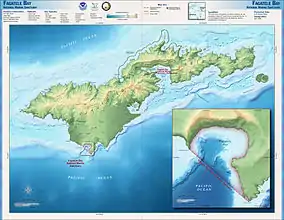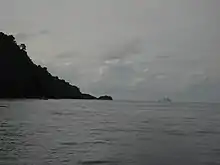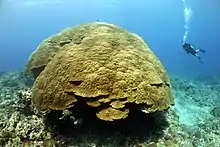National Marine Sanctuary of American Samoa
The National Marine Sanctuary of American Samoa (formerly the Fagatele Bay National Marine Sanctuary[1]) is a national marine sanctuary in American Samoa. It is the smallest, yet one of the most important, marine sanctuaries as it is home to more fish and marine mammals than any other marine sanctuary. It also provides a natural food source for sharks and other predators of the ocean.
| National Marine Sanctuary of American Samoa | |
|---|---|
| Fagatele Bay National Marine Sanctuary (former)[1] | |
 | |
| Location | American Samoa:
|
| Coordinates | 14°21′54″S 170°45′54″W[lower-alpha 1] |
| Area | 13,581 sq mi (35,170 km2) |
| Established | 1986,[lower-alpha 2] expanded 2012 |
| Governing body | National Oceanic and Atmospheric Administration |
| americansamoa | |
Description
The National Marine Sanctuary of American Samoa comprises a fringing coral reef ecosystem nestled within an eroded volcanic crater on the island of Tutuila, American Samoa. This smallest and most remote of all the National Marine Sanctuaries is the only true tropical reef in the program. While it is one of the most protected and beautiful, it also bears the scars of some recent and severe natural disasters.
The Fagatele Bay portion of the sanctuary is completely contained in the 0.25 square miles (0.65 km2) of the bay. The land surrounding the bay resides in the hands of the families who have lived near the bay's slopes for thousands of years. Fortunately, there is little development in the watershed and the one reliable stream that empties near the beach runs clear and clean.
Fagatele Bay is a vibrant tropical reef marine ecosystem, filled with all sorts of brightly colored tropical fish, including parrot fish, damselfish and butterfly fish, as well as other sea creatures like lobster, crabs, sharks and octopus. From June to September, southern humpback whales migrate north from Antarctica to calve and court in Samoan waters. Visitors can hear courting males sing whale songs, which the whales may be using to attract mates. Several species of dolphin, as well as threatened and endangered species of sea turtles, such as the hawksbill and green sea turtle, are frequently seen swimming in the bay as well. Recreational activities such as diving, snorkeling, and fishing can be enjoyed at the sanctuary.
Fagatele Bay as a Marine Sanctuary

Fagatele Bay National Marine Sanctuary was designated in 1986 in response to a proposal from the American Samoa Government to the National Marine Sanctuary Program. The National Marine Sanctuary Program supports research in all of its 14 sites. Research plays a role in management by supplying information needed to make resource protection decisions based on hard scientific data. Fagatele Bay's most important research project spans over a decade. In the late 1970s, millions of Acanthaster planci or crown-of-thorns starfish (alamea), a coral-eating animal, ate their way through Tutuila's reefs. More than 90 percent of all the living corals were destroyed. At the time, Fagatele Bay was not a National Marine Sanctuary, but this disaster propelled the decision for the site's designation.
The National Marine Sanctuary Program protects and preserves nature and local culture. The program is found in areas of special significance such as the oceans and Great Lakes of the United States. There are 14 sanctuaries in the program ranging from Stellwagen Bank off Cape Cod to the Channel Islands in southern California. All manage their precious resources through a combination of education, research, long-term monitoring, regulation and enforcement.
Many different types of fish call this reef home, and many biologists and marine researchers attempt to cooperate with the local government in an effort to find new species within the local waters. Many new species have been found, but as it is a marine sanctuary, fish or other marine animals cannot be removed from the ecosystem. Scientists, headed up by Dr. Charles Birkenland, used the starfish's destruction as a focus of their long-term research: to follow the recovery of a coral reef. Because corals grow slowly, the research team chose a multi-year cycle of data collection. Beginning in 1985, and again in 1988, 1995, 1998, 2001 and 2004, the team amassed information on coral, fishes, invertebrates and marine plants. This database is unique for Samoa and the study is one of the few long-running surveys of its type in the world
Education
The sanctuary sponsors education programs, such as the EnviroDiscoveries Camp, which is an outdoor activity and learning camp for 9- to 12-year-olds. Scientific programs include a continuing resource assessment survey, begun in 1985, and coral reef monitoring. Sanctuary regulations prohibit taking invertebrates and sea turtles, as well as historical artifacts. Only traditional fishing methods are permitted in the inner bay.
The sanctuary makes a special effort to work with the American Samoan community with outreach programs for all ages. The sanctuary co-sponsors a summer environmental education program for 9- to 12-year-old children. These programs explore the marine life in the bay, including ancient reef-dwellers and solar-powered clams, teaching ways to protect the resources there. Samoan cultural events and general community outreach/education programs are also run year-round.
The sanctuary also provides guided tours of the area, and allows any student to come on field-trips, for which they provide educational guides. They also emphasize the cultural aspects of the reefs and the wildlife, so as to combine traditional culture with the scientific knowledge students learn in school. The sanctuary also aids local education by organizing projects for the High Schoolers on the island, to further reinforce the necessity of the National Marine Sanctuary.
Big Momma

Also known as Big Mama and Fale Bommie,[2] Big Momma is the biggest known coral on planet Earth.[3] It is located in the Valley of Giants in the National Marine Sanctuary of American Samoa.[4] It is 21 feet tall, and its circumference is 134 feet. Its diameter is longer than 4 average limousines! It is over 500 years old. Its scientific name is Porites lobata. NOAA provides an interactive virtual dive to look at Big Momma from many angles.[5]
Animals
- Grouper: Cephalopholis or Epinephelus
- Parrot fish: Bolbometopon muricatum, Leptoscarus viagiensis, Sparisoma viride, Scarus iseri and Sparisoma cretense
- Damselfish: Chromis chromis
- Butterfly fish: Chaetodon lineolatus, Chaetodon lunula
- Southern humpback whales: Megaptera
- Dolphin: Delphinus capensis, Tursiops truncatus, Stenella longirostris, Lagenorhynchus obliquidens,
- Hawksbill sea turtle: Eretmochelys imbricata
- Green sea turtle: Chelonia mydas
- Starfish: Acanthaster planci, Linckia laevigata
Staff
Nancy Daschbach is Fagatele Bay's on-site manager. Americorps volunteers assist the outreach program. Staff members are American Samoa Government employees based in Pago Pago, American Samoa and operate through a cooperative agreement between the National Oceanic and Atmospheric Administration and American Samoa's Economic and Development Planning Office, as well as the National Marine Sanctuary Association (NMSA). The volunteers typically work for 3 months and then take the rest of the time off, but a volunteer can work enough to become a paid worker for the NMSA or even take a Manager position at another Marine Sanctuary.
Notes
- Coordinates at Fagatele Bay.
- As Fagatele Bay National Marine Sanctuary.
References
- http://americansamoa.noaa.gov National Marine Sanctuary of American Samoa. NOAA.gov. Retrieved 1 January 2018.
- https://scubadiverlife.com/diving-national-marine-sanctuary-american-samoas-big-momma/
- https://sanctuaries.noaa.gov/earthisblue/wk146-protecting-big-momma.html
- https://sanctuaries.noaa.gov/vr/american-samoa/big-momma/
- https://sanctuaries.noaa.gov/vr/american-samoa/big-momma/
External links
| Wikimedia Commons has media related to National Marine Sanctuary of American Samoa. |